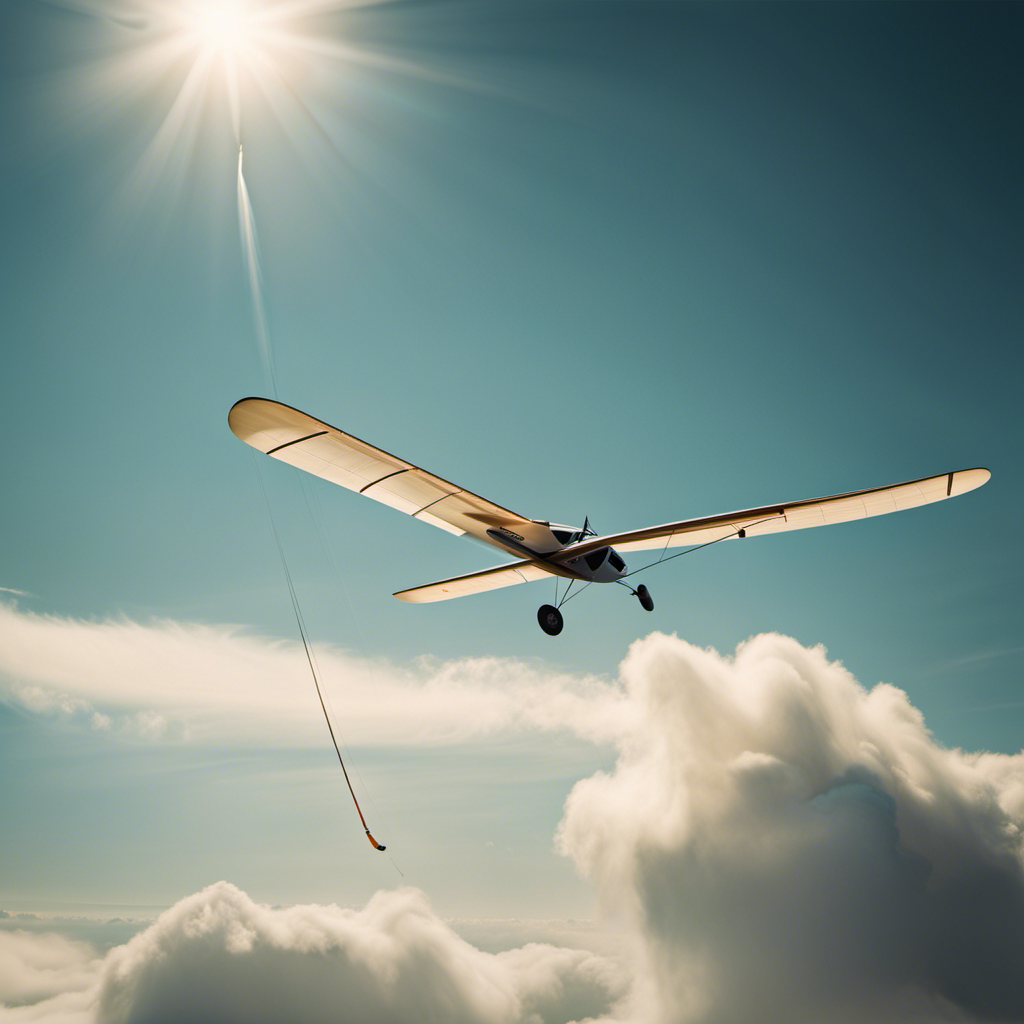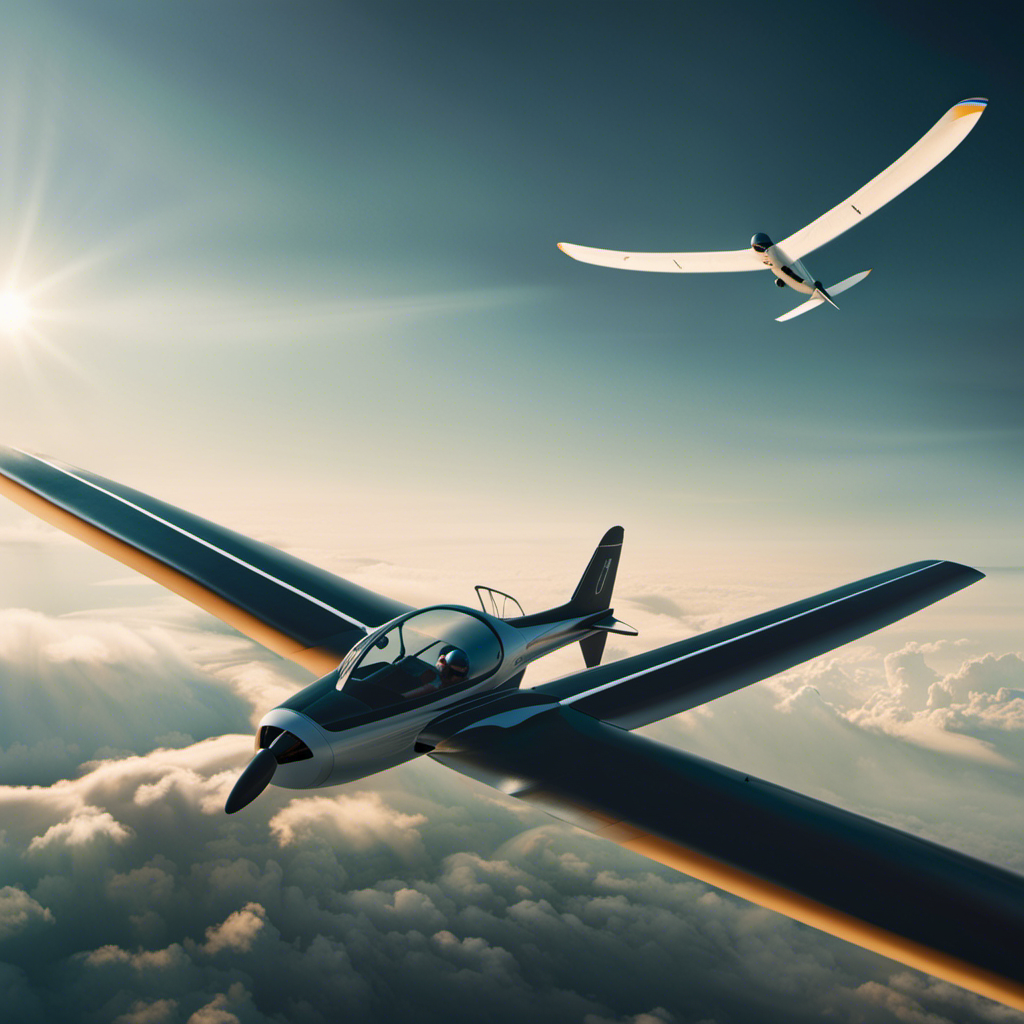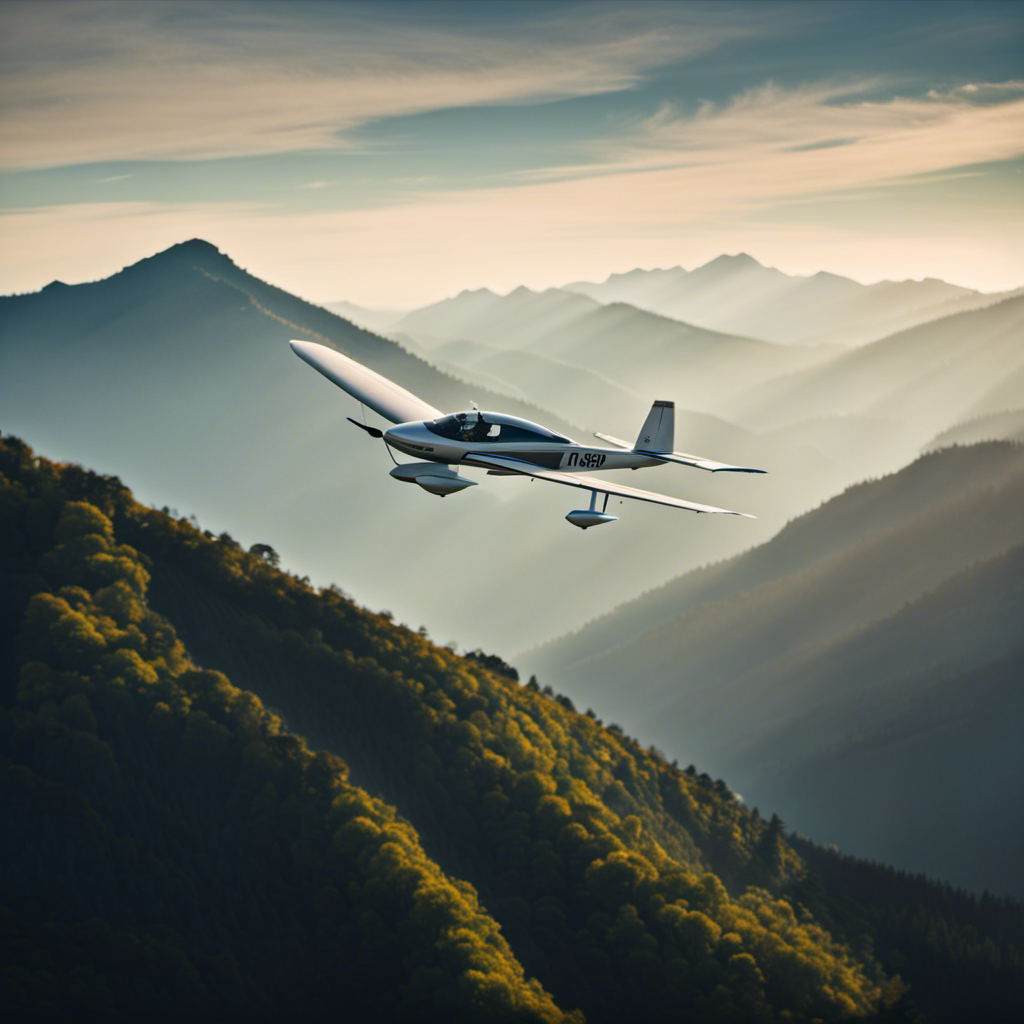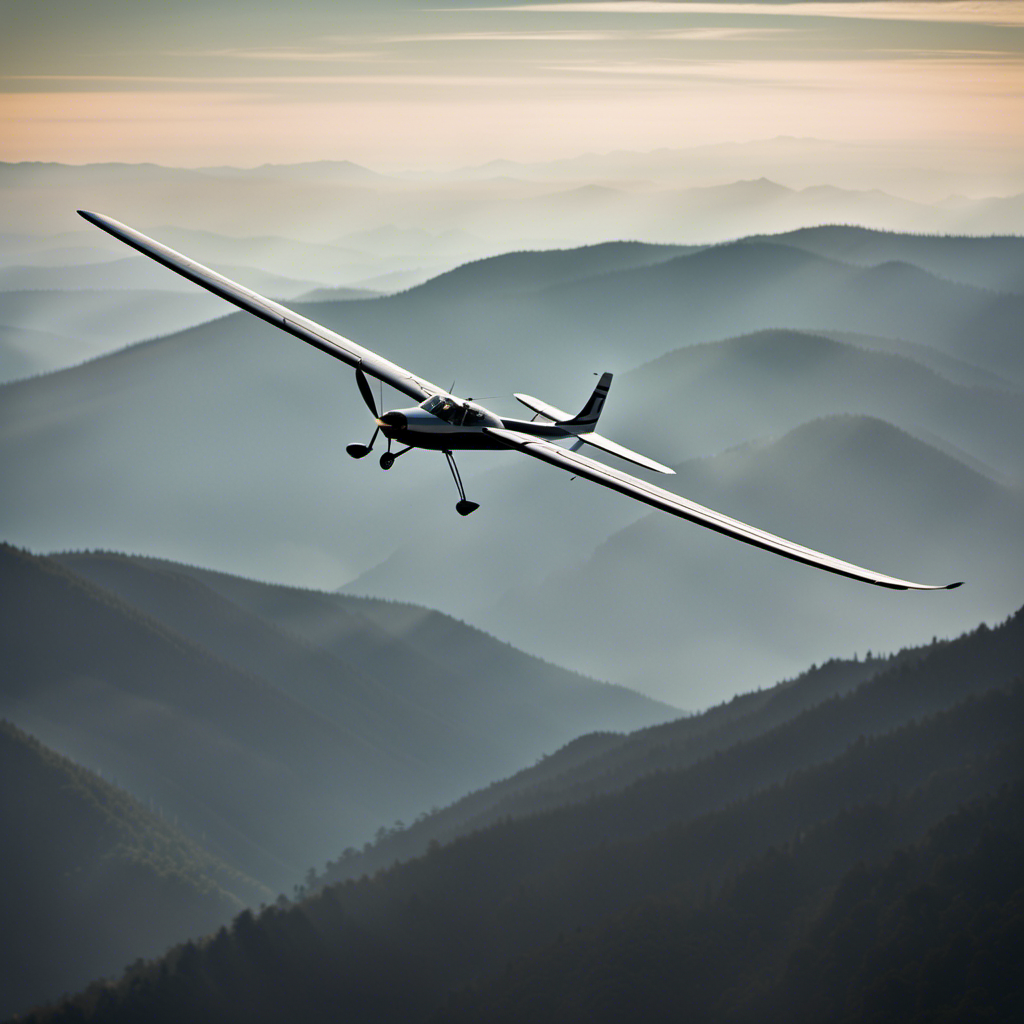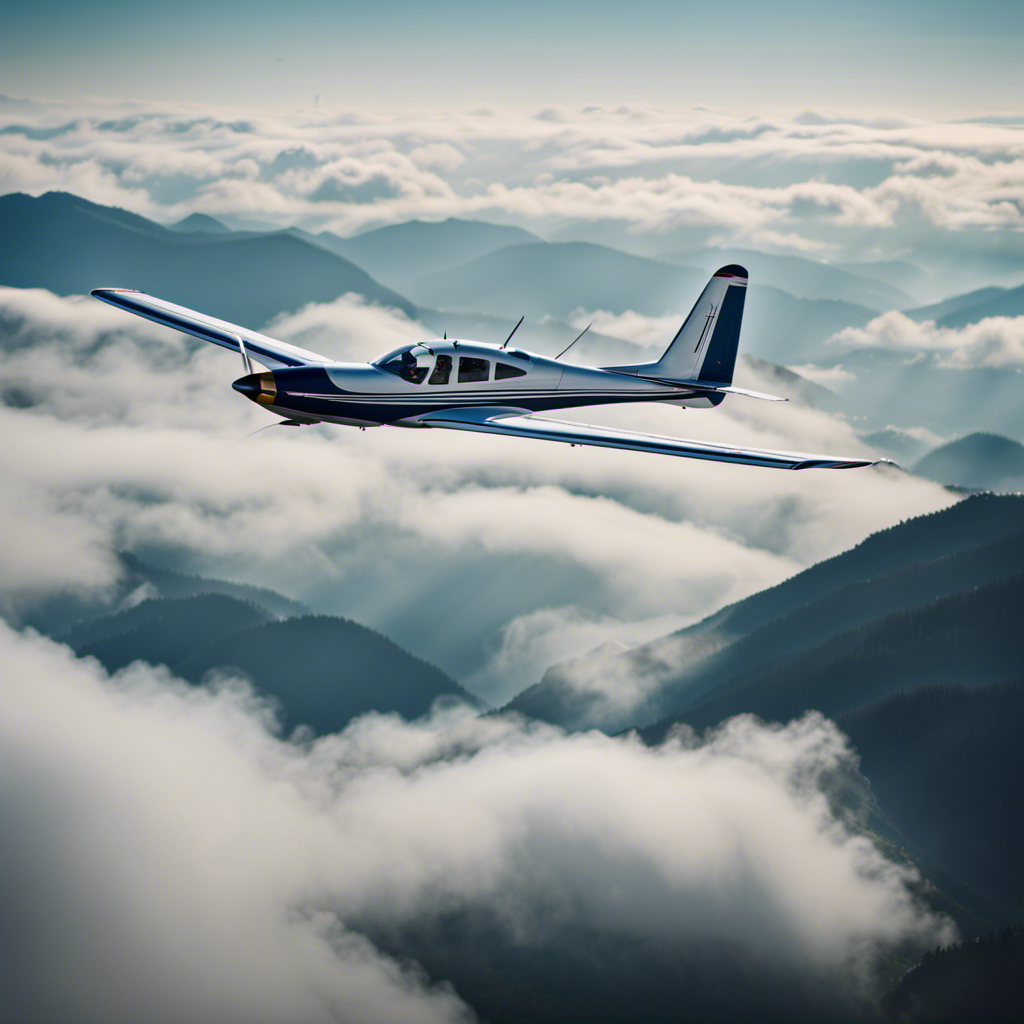As a glider pilot, I am always amazed by the ability of these remarkable aircraft to soar without the need for an engine. It may seem counterintuitive, but it serves as a strong testament to the laws of physics and the ingenuity of aircraft engineers.
In this article, we will delve into the intricacies of glider flight, exploring the role of lift and drag, the power of gravity, and the various launching techniques that enable these graceful machines to soar through the sky.
Join me on this journey as we unravel the secrets of glider takeoff.
Key Takeaways
- Gliders operate without an engine and rely on natural forces like thermals and ridge lift.
- Gliders enhance flying skills due to the lack of engine assistance, requiring a deep understanding of aerodynamics.
- Gliders use weight shifting and rudder control for maneuvering, executing smooth turns, and accurate landings.
- Gliding offers a unique and exhilarating experience, attracting aviation enthusiasts and providing a sense of freedom and serenity in the air.
Understanding the Basics of Glider Flight
Now let’s dive into how you can understand the basics of glider flight.
Glider aerodynamics is a complex but fascinating topic. To grasp the fundamentals, it is crucial to comprehend the concepts of lift and drag.
Lift is the force that opposes gravity and keeps the glider airborne. It is generated by the shape of the wings, known as airfoils, which create a pressure difference between the upper and lower surfaces.
Drag, on the other hand, is the resistance encountered by the glider as it moves through the air. It is caused by factors such as air friction and the shape of the glider.
Understanding the interplay between lift and drag is essential in comprehending how gliders take off without an engine.
The Role of Lift and Drag in Glider Takeoff
During takeoff, gliders rely on the forces of lift and drag to become airborne. The role of lift is crucial in overcoming the weight of the glider and enabling it to leave the ground. Lift is generated by the shape of the glider’s wings, which creates a pressure difference that lifts the glider upwards.
However, drag also plays a significant role in takeoff. Drag is the resistance the glider encounters as it moves through the air, and it must be managed carefully to ensure a smooth takeoff. Glider pilots employ various techniques, such as reducing drag by keeping the glider’s wings level and minimizing any unnecessary movements. These techniques can be challenging, as even the slightest deviation can affect the glider’s ability to achieve the necessary lift and overcome its weight.
Now, let’s delve into how gliders harness the power of gravity to stay airborne.
Harnessing the Power of Gravity: How Gliders Stay Airborne
To stay airborne, I rely on the power of gravity as a glider pilot. By harnessing gravity and utilizing aerodynamic principles, I am able to maintain altitude and glide through the air.
Gravity acts as a force that pulls the glider downwards, providing the necessary energy to generate lift. As the glider moves through the air, the wings create lift by utilizing the Bernoulli’s principle and the shape of the airfoil. This lift, combined with the glider’s low drag design, allows me to soar through the sky without the need for an engine.
Now, let’s transition into the next section where we will discuss the various launching techniques such as tow lines and winches that aid in getting the glider off the ground.
Launching Techniques: Tow Lines and Winches
Launching techniques such as tow lines and winches are used to get gliders off the ground. Cable launches involve a tow line attached to the glider, which is then pulled by a motorized winch. The winch rapidly reels in the tow line, propelling the glider forward and into the air. This method provides a quick and efficient way to launch gliders.
Another technique used is bungee launches, where the glider is attached to a strong elastic cord. As the cord is released, it rapidly recoils, providing a powerful launch. These launching techniques allow gliders to overcome their lack of engines and achieve flight.
Now, let’s delve into the soaring techniques glider pilots use once they’re airborne, such as riding thermals and ridge lift.
Soaring Techniques: Riding Thermals and Ridge Lift
Once you’re airborne, you can ride thermals and ridge lift to gain altitude and extend your flight time.
Riding thermals involves finding areas of warm, rising air and circling within them to climb higher. These thermals are created by the sun heating the ground, causing the air to rise. By staying within the thermal, gliders can gain altitude without the need for an engine.
Ridge soaring, on the other hand, involves flying along the edge of a hill or mountain where the wind is forced upwards. As the air rises, gliders can use it to gain altitude and continue their flight. These techniques require careful observation of wind patterns and skillful piloting to make the most of the available lift.
Now, let’s delve into the fascinating world of glider design, including wings, fuselage, and control surfaces.
Glider Design: Wings, Fuselage, and Control Surfaces
When you’re flying a glider, the wings, fuselage, and control surfaces are crucial components that help you maneuver in the air. Glider stability and aerodynamics optimization are key factors in designing these components.
Here are some details to give you a better understanding:
-
Wings:
-
Wings provide lift by generating a pressure difference between the upper and lower surfaces.
-
The shape, size, and airfoil section of the wings are carefully designed for maximum lift and minimum drag.
-
Fuselage:
-
The fuselage houses the pilot, controls, and the structure that connects the wings and tail.
-
It is streamlined to minimize drag and enhance glider performance.
-
Control Surfaces:
-
The ailerons on the wings control roll, allowing the glider to bank left or right.
-
The elevator on the tail controls pitch, allowing the glider to climb or descend.
These components work together to ensure stability and optimize the glider’s aerodynamics.
Now, let’s explore the pilot skills and techniques for glider takeoff.
Pilot Skills and Techniques for Glider Takeoff
Transition: Now that we have a solid understanding of glider design, let’s delve into the skills and techniques required by pilots for successful takeoff.
As a glider pilot, I undergo rigorous training to master the aerodynamics of glider flight. This involves studying the principles of lift, drag, and gravity, and how they interact with the glider’s wings and control surfaces. A key aspect of pilot training is learning to exploit rising air currents, such as thermals or ridge lift, to gain altitude and extend flight time.
To provide a concise overview of the pilot skills and techniques involved in glider takeoff, I have created the following table:
| Skills and Techniques for Glider Takeoff |
|---|
| Proper weight and balance |
| Correct positioning of control surfaces |
| Utilizing aerodynamic forces |
| Skillful management of air currents |
Safety Measures and Precautions in Glider Flight
To ensure your safety during glider flight, it is important to follow proper safety measures and precautions.
Before takeoff, make sure the glider is thoroughly inspected for any signs of damage or malfunction. Check the control surfaces, cables, and instruments to ensure they are working properly.
It is crucial to wear a properly fitted helmet and secure all loose items. In case of an emergency, familiarize yourself with the emergency procedures, such as how to handle an in-flight emergency or an unexpected landing. Always have a communication device and a survival kit on board.
Additionally, stay updated with the weather conditions and be prepared to adjust your flight plan accordingly.
By following these safety precautions, you can ensure a safe and enjoyable glider flight experience.
Now, let’s transition into the subsequent section about glider landing: techniques and challenges.
Glider Landing: Techniques and Challenges
Glider pilots must master various techniques and overcome challenges when landing their aircraft. Landing a glider requires precision and skill, as there is no engine to control the descent. Here are some key techniques and challenges faced during glider landings:
-
Landing Gear:
-
Gliders typically have a fixed landing gear, which consists of a skid or a wheel.
-
The landing gear must be properly aligned with the runway to ensure a smooth touchdown.
-
Approach Techniques:
-
Pilots use various approaches, such as the ‘dead stick’ technique, where the glider is landed without any power.
-
The ‘flapless’ approach is another technique used to control the glide ratio and decrease the landing distance.
Mastering these techniques and overcoming challenges like wind conditions and runway length requires extensive training and experience. Glider pilots must rely on their knowledge, judgment, and skill to execute a safe and successful landing.
Transitioning to the subsequent section about the thrill of gliding: why gliders are a popular choice for aviation enthusiasts, glider landings showcase the precise control and finesse required in this exhilarating sport.
The Thrill of Gliding: Why Gliders are a Popular Choice for Aviation Enthusiasts
If you’re an aviation enthusiast, you’ll love the thrill of gliding and understand why gliders are a popular choice.
Glider competitions and glider clubs provide the perfect platform for enthusiasts to showcase their skills and experience the exhilaration of soaring through the sky.
In glider competitions, pilots compete against each other in various tasks, such as distance flying, speed racing, and precision landing. These events test their ability to navigate thermals, utilize ridge lift, and make strategic decisions.
Glider clubs offer a supportive community where enthusiasts can share their passion, learn from experienced pilots, and gain valuable flying experience.
With no engine to rely on, gliders require precise piloting techniques and a deep understanding of aerodynamics, making them a thrilling choice for aviation enthusiasts.
Frequently Asked Questions
How do gliders maintain altitude without an engine?
To maintain altitude without an engine, gliders rely on thermals and ridge lift. Thermals are upward currents of warm air that gliders can use to gain altitude, while ridge lift is created when wind hits a hill or ridge and is forced to rise, providing lift. Additionally, weight and balance play a crucial role in maintaining altitude.
What are the different launching techniques used for gliders?
There are two common launching techniques used for gliders: winch launching and aerotow. With winch launching, a powerful winch pulls the glider into the air using a cable. In aerotow, a powered aircraft tows the glider into the air using a towline.
What are the primary factors that determine glider design?
The primary factors that determine glider design are glider efficiency and wing design. These factors are crucial in achieving optimal performance and maximizing the glider’s ability to stay aloft for extended periods without the aid of an engine.
What are some safety measures and precautions to consider when flying a glider?
When it comes to flying a glider, safety measures and precautions are of utmost importance. From pre-flight inspections to proper training, every step must be taken to ensure a smooth and secure flight experience.
What are the main challenges faced during glider landings?
During glider landings, the main challenges are maintaining proper speed and altitude, judging the wind conditions, and executing precise maneuvers to achieve a smooth touchdown. Various techniques, such as slip and flare, are used to overcome these challenges.
Conclusion
In conclusion, gliders are able to take off without an engine by utilizing the principles of lift and drag, as well as harnessing the power of gravity. Through various launching techniques such as tow lines and winches, gliders are able to achieve the necessary initial speed and altitude.
Once airborne, pilots rely on soaring techniques like riding thermals and ridge lift to maintain and gain altitude. With proper pilot skills, safety measures, and landing techniques, gliding becomes a thrilling and popular choice for aviation enthusiasts.
As the saying goes, "Gliding is like dancing with the wind, gracefully floating through the sky."
With a heart that soars as high as the skies, Aria, affectionately known as “Skylark,” is the driving force behind Soaring Skyways. Her journey into the gliding world began as a young dreamer gazing up at the soaring birds, yearning to experience the weightlessness and freedom they embodied. With years of experience both in the cockpit and behind the scenes, Aria’s commitment to the gliding community is unwavering.
